|
Harp Guitars at Healdsburg Trip
Report: The Healdsburg Guitar Festival, |
| The Healdsburg Guitar
Festival is the premiere event for luthiers to show their wares.
The festival gets its name from the Photos by Frank Doucette and Christa Percival |
|
|
The next harp guitar I
found was just one row over from Big Red.
This is the creation of |
|
|
|
|
|
My friend Kathy Wingert had a table right across the aisle from Duane. Kathy is one of my absolute favorite guitar makers. She accepted her first commission for a harp guitar (from me) in 2005. We’ve just about agreed on the final design (more on that in future). Here’s Kathy with her daughter Jimmi. Jimmi is a talented inlay artist who has done work for several fine luthiers.
|
|
I had been so taken with
Big Red that I completely missed a harp guitar displayed just a few feet
away. I only noticed it when
going back through the festival to visit |
|
Other known harp guitar builders displayed instruments at the festival, but did not have any harp guitars with them. The ones that I noticed were Charles Hoffman, Lance McCollum, Alan Perlman, and Mike Doolin (shown here). Even if one is not in
the market for a new guitar, harp guitar, or other instrument, there is
still much to occupy one’s time at The Healdsburg Guitar Festival.
There are workshops throughout the weekend, for players and
luthiers, taught by top professionals.
I took a wonderful workshop in Brazilian Guitar (a recent
obsession) led by master luthier, player, teacher
|
|
Tim Brookes, author of Guitar: An American Life – the summer best-seller among harpguitars.net forum readers, was also on hand for a lecture and book signing. Tim is just as engaging in person as one might imagine from reading the book. After his presentation, Tim invited people up on stage to try out the very guitar chronicled in the book (his daughter really was right about those blue lines around the binding). The evenings are devoted to concerts featuring some of the world’s most highly regarded acoustic guitarists. Concerts this year included the gypsy swing of John Jorgenson, fiery flatpicking from Beppe Gambetta and Dan Crary, and fine fingerpicking from Franco Morone and Todd Hallawell. The 2005 festival also included a number of vendors not selling guitars. You could buy anything from wood, guitar hardware, and various guitar accessories to CDs, books, DVDs, and insurance. I particularly enjoyed the substantial discounts offered by Mel Bay Publishing on their books and DVDs. I also enjoyed talking with a representative from Heritage Insurance. Their musical instrument policies seem to offer broad coverage for a reasonable rate based on instrument value. |
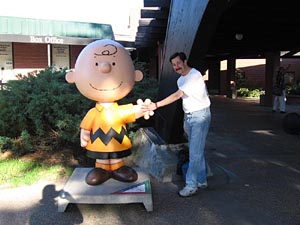
(Thanks to my wife Christa Percival for many of these photos.) |
My wife, who was not
thrilled about the idea of ending our vacation with a guitar festival,
actually enjoyed herself at the festival, and in exploring the
surrounding area. The Healdsburg Guitar Festival happens every 2 years in mid-August. I highly recommend a trip to the festival for luthiers, players, and all lovers of great guitar music. Check out the 2005 festival website at www.festivalofguitars.com. --Frank Doucette |
|
P.S. One other part of this trip that I wanted to mention was a stop to visit master luthier Ed Claxton. Ed’s focus is on 6-string steel and nylon string guitars. He has, however, built more unusual instruments like ouds and hurdy gurdys. I asked him if he’d ever consider making a harp guitar. He said he’d love to and was actually surprised that he’d not managed to get around to building one before. He just needs a customer who wants one. Check out a full article on Ed, with video, in the first issue of Acoustic Player Magazine (www.acousticplayermagazine.com). |
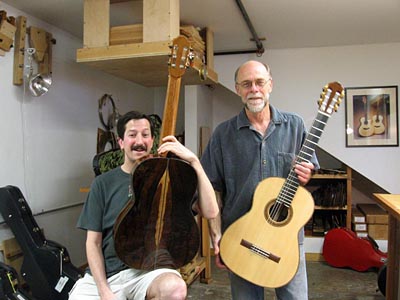 |
|
About the Author Frank Doucette lives in Los Angeles with his wife, artist Christa Percival (www.percivalproductions.com), and their two young children (parakeets) Riff-Raff and Kina. Frank has a Diploma in Fingerstyle Guitar Performance from The Wisconsin Conservatory of Music. Part of his studies there included private harp guitar lessons with renowned author and educator John Stropes. Frank is interested in a wide variety of music and is now working to find his own musical voice in influences such as Celtic music, Brazilian Music, Jazz, and more. An avid history buff, he enjoys studying the cultural and socio-political conditions that have fostered various musical traditions. Before moving to California from his native Massachusetts, Frank taught at, and helped develop instructional manuals for, Wolfman’s School of Music, the only private music school ever to be endorsed by the Berklee College of Music. In his spare time, Frank is a Financial Aid Administrator for the UCLA School of Dentistry. |
|
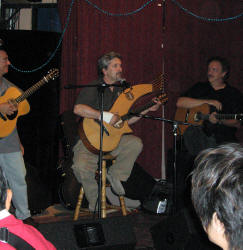 |
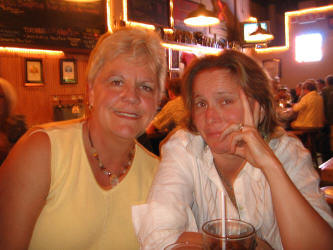 |
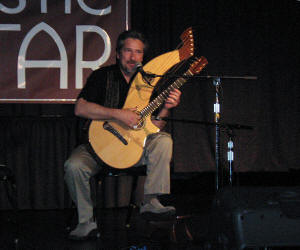 |
| Saturday night, I played the Russian Brewery Pub with Don Alder, Doug Young (at right) and others. Patron noise levels weren't very forgiving for Duane Noble's unamplified harp guitar. | Two of the noise makers were Duane's wife, Lolly, and Frank's wife Christa. | The next day (Sunday) I played Duane's brand new harp guitar (see photos) for his 20 minute demo. A pleasure and an honor! |
|
Absent from this photo gallery are shots of Frank Doucette's brand new Kathy Wingert harp guitar - look for the upcoming feature soon! The Fretboard Journal editors were on hand as well, and posted photos at Fred's booth on their blog here. |
||
|
If you enjoyed this page, or found it useful for research, please consider supporting Harpguitars.net so that this information will be available for others like you and to future generations. Thanks! |
|
|
|
All Site Contents Copyright © Gregg Miner, 2004,2005,2006,2007. All Rights Reserved. Copyright and Fair Use of material and use of images: See Copyright and Fair Use policy. |